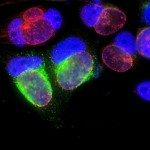Link to Pubmed [PMID] – 16309458
Cell. Microbiol. 2005 Dec;7(12):1714-22
Chlamydia are widespread bacteria that grow in human and animal cells. They enter their host cell, establish an intracellular environment favourable for their multiplication and finally exit the host cell. A combination of host cell factors and of bacterial proteins contribute to pathogen entry. Recent advances have shed new light on the entry mechanism, following attachment. Here we review recent data concerning endocytosis, host cell signalling, proteins secreted by the bacteria, the actin cytoskeleton in entry and the involvement of small GTPases.

